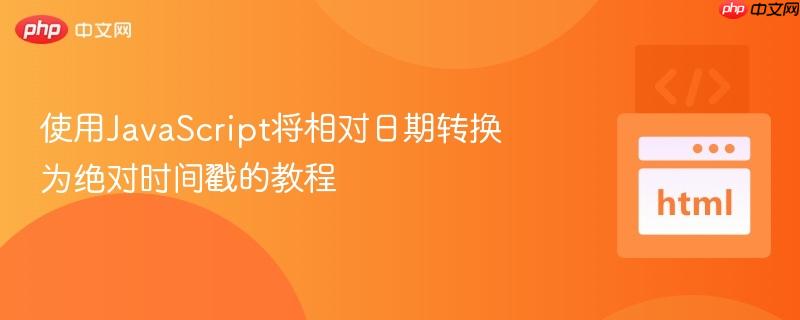
本教程详细介绍了如何利用JavaScript,将网页中显示的相对日期(如“X月Y天前”)动态转换为其对应的绝对时间戳。通过解析HTML元素的data属性,我们可以轻松获取隐藏的精确日期信息,并通过简单的DOM操作更新页面显示,从而提升用户体验和数据可读性。
在现代Web应用中,为了提供更友好的用户体验,日期和时间常常以相对形式(例如“3天前”、“2小时前”)显示。然而,在某些场景下,用户可能需要查看精确的绝对时间戳,以便进行数据分析或历史追溯。幸运的是,许多开发者在HTML结构中预留了这些精确数据,通常存储在元素的data属性中。本教程将指导您如何使用JavaScript动态地将页面上显示的相对日期转换为其对应的绝对时间戳。
首先,我们需要识别包含相对日期和绝对时间戳的HTML元素。通常,相对日期会作为元素的文本内容显示,而绝对时间戳则隐藏在同一个元素的自定义data属性中。
考虑以下常见的HTML结构示例:
立即学习“Java免费学习笔记(深入)”;
<tr id="job-id" class="job-id-class someotherclass-id">
<td data="2021-12-17T06:32:13Z">
9 mo 10 days -
<a href="job/agent-info/lastSuccessfulBuild/" class="model-link inside">#2170</a>
</td>
</tr>在这个例子中:
我们的目标是提取 data 属性的值,并用它替换掉 <td> 元素的相对日期文本。
要实现这一转换,我们可以编写一个简单的JavaScript函数。该函数将执行以下步骤:
以下是一个实现此功能的JavaScript函数示例:
/**
* 替换指定单元格中的相对日期为data属性中的绝对时间戳。
*
* @param {string} selector 用于选择目标HTML元素的CSS选择器。
*/
function replaceRelativeDateWithTimestamp(selector) {
// 1. 使用querySelector选择第一个匹配的<td>元素
// 注意:在实际应用中,建议使用更具体的选择器(如ID或类)以避免误选。
let targetCell = document.querySelector(selector);
// 2. 检查元素是否存在,防止运行时错误
if (targetCell) {
// 3. 获取data属性的值
const timestamp = targetCell.getAttribute('data');
// 4. 检查data属性是否存在
if (timestamp) {
// 5. 更新元素的第一个文本节点的内容
// firstChild通常指向元素内的第一个文本节点或子元素。
// 对于本例,' 9 mo 10 days -'是第一个文本节点。
targetCell.firstChild.data = timestamp + ' - ';
console.log(`日期已更新为: ${timestamp}`);
} else {
console.warn(`元素 ${selector} 没有 'data' 属性。`);
}
} else {
console.warn(`未找到匹配选择器 ${selector} 的元素。`);
}
}为了演示上述函数的效果,我们可以创建一个包含示例HTML和触发转换的按钮:
<!DOCTYPE html>
<html lang="zh-CN">
<head>
<meta charset="UTF-8">
<title>相对日期转绝对时间戳</title>
<style>
table, th, td {
border: 1px solid #ccc;
border-collapse: collapse;
padding: 8px;
}
button {
margin-top: 15px;
padding: 10px 20px;
cursor: pointer;
}
</style>
</head>
<body>
<h1>日期显示转换示例</h1>
<table>
<thead>
<tr>
<th>构建日期</th>
</tr>
</thead>
<tbody>
<tr id="job-build-row">
<td data="2021-12-17T06:32:13Z" class="build-date-cell">
9 mo 10 days -
<a href="job/agent-info/lastSuccessfulBuild/" class="model-link inside">#2170</a>
</td>
</tr>
<tr id="another-build-row">
<td data="2023-01-25T14:00:00Z" class="build-date-cell">
1 year 3 months ago -
<a href="job/another-agent/lastSuccessfulBuild/" class="model-link inside">#1001</a>
</td>
</tr>
<tr>
<td class="no-data-cell">
This cell has no data attribute.
</td>
</tr>
</tbody>
</table>
<br>
<button onclick="replaceRelativeDateWithTimestamp('.build-date-cell')">转换所有构建日期</button>
<script>
// 上面定义的 replaceRelativeDateWithTimestamp 函数
function replaceRelativeDateWithTimestamp(selector) {
let targetCells = document.querySelectorAll(selector); // 使用querySelectorAll处理多个元素
targetCells.forEach(targetCell => {
if (targetCell) {
const timestamp = targetCell.getAttribute('data');
if (timestamp) {
// 确保只修改第一个文本节点,避免影响<a>标签
let firstTextNode = Array.from(targetCell.childNodes).find(node => node.nodeType === Node.TEXT_NODE && node.nodeValue.trim() !== '');
if (firstTextNode) {
firstTextNode.data = timestamp + ' - ';
} else {
// 如果没有文本节点,直接设置innerText或textContent
targetCell.textContent = timestamp + ' - ' + targetCell.textContent.replace(/\s*-\s*/, ''); // 保留原有链接文本
}
console.log(`日期已更新为: ${timestamp}`);
} else {
console.warn(`元素 ${selector} 没有 'data' 属性。`);
}
} else {
console.warn(`未找到匹配选择器 ${selector} 的元素。`);
}
});
}
</script>
</body>
</html>在上述代码中,我们对 replaceRelativeDateWithTimestamp 函数进行了优化,使其能够处理多个匹配的元素(通过 querySelectorAll 和 forEach 循环),并且更健壮地查找和修改第一个非空文本节点,以避免意外删除或修改子元素(如 <a> 标签)。
通过利用HTML元素的 data 属性和简单的JavaScript DOM操作,我们可以有效地将网页中显示的相对日期动态转换为精确的绝对时间戳。这种方法不仅提升了数据可读性,也为用户提供了更丰富的信息。遵循本文提供的示例和最佳实践,您可以轻松地将此功能集成到您的Web应用中。
以上就是使用JavaScript将相对日期转换为绝对时间戳的教程的详细内容,更多请关注php中文网其它相关文章!

每个人都需要一台速度更快、更稳定的 PC。随着时间的推移,垃圾文件、旧注册表数据和不必要的后台进程会占用资源并降低性能。幸运的是,许多工具可以让 Windows 保持平稳运行。

Copyright 2014-2025 https://www.php.cn/ All Rights Reserved | php.cn | 湘ICP备2023035733号